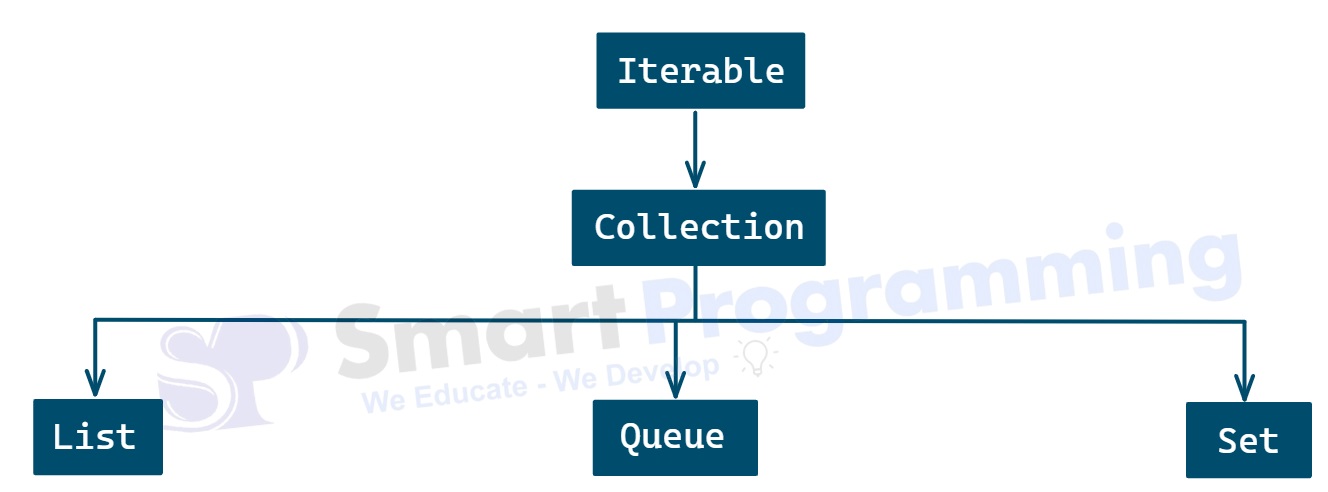Collection Interface in Java
Introduction
- Collection Interface is the root interface of the Collections Framework in Java.
-
It is present in the
java.utilpackage. - It was introduced in JDK 1.2 version.
-
Hierarchy of Collection Interface:
-
- It represents a group of objects, known as elements.
- It defines the most common methods that every collection class (like List, Queue, Set) should implement.
-
Syntax :
public interface Collection<E> extends Iterable<E> { // methods (abstract and default) }
Methods of Collection Interface:
-
Below are the methods defined specifically in the
Collectioninterface:
| Sr. No. | Method | Description |
|---|---|---|
| 1 | boolean add(E e) |
Adds a single element to the collection. Returns true if the collection changed. |
| 2 | boolean addAll(Collection<? extends E> c) |
Adds all elements from another collection. Returns true if the collection changed. |
| 3 | boolean contains(Object o) |
Checks if the collection contains the specified element. Returns true if found. |
| 4 | boolean isEmpty() |
Checks if the collection has no elements. Returns true if empty. |
| 5 | boolean remove(Object o) |
Removes a single instance of the specified element. Returns true if removed. |
| 6 | void clear() |
Removes all elements from the collection, making it empty. |
| 7 | int size() |
Returns the number of elements in the collection. |
| 8 | Iterator<E> iterator() |
Returns an Iterator to traverse elements one by one. |
| 9 | Object[] toArray() |
Converts the collection into an array of Object. |
| 10 | <T> T[] toArray(T[] a) |
Converts the collection into an array of the specified type. |
| 11 | boolean containsAll(Collection<?> c) |
Checks if the collection contains all elements of the specified collection. |
| 12 | boolean removeAll(Collection<?> c) |
Removes all elements in this collection that are also contained in the specified collection. |
| 13 | boolean retainAll(Collection<?> c) |
Retains only the elements in this collection that are also contained in the specified collection. |
| 14 | default boolean removeIf(Predicate<? super E> filter) |
Removes all elements that satisfy the given predicate. (Java 8+) |
| 15 | default Stream<E> stream() |
Returns a sequential Stream with this collection as the source. (Java 8+) |
| 16 | default Stream<E> parallelStream() |
Returns a possibly parallel Stream with this collection as the source. (Java 8+) |
| 17 | default Spliterator<E> spliterator() |
Creates a Spliterator over the elements in this collection. (Java 8+) |
Program:
-
Note:
-
To use the Collection interface in a program, you must create an object of one of its implemented classes such as
ArrayList,HashSet, orLinkedList. - Hence, having a basic understanding of these classes is recommended before working with the Collection interface.
-
To use the Collection interface in a program, you must create an object of one of its implemented classes such as
-
Collection simple generic program that works with any type of collection (
List,Set,Queue).import java.util.*; public class CollectionDemo { public static void printCollection(Collection<String> collection) { for (String element : collection) { System.out.println(element); } } public static void main(String[] args) { Collection<String> list = new ArrayList<>(); list.add("Amit"); list.add("Deepak"); printCollection(list); System.out.println("-----------"); Collection<String> set = new HashSet<>(); set.add("Kamal"); set.add("Rahul"); printCollection(set); } }Output:
Amit Deepak ----------- Rahul Kamal
Use of Collection Interface:
-
Maximum Flexibility:
-
Use a
Collectionreference when we want our code should work with any type of collection (List, Set, or Queue) and we don't need special features like indexed access.
-
Use a
-
Easy to Maintain:
-
If a method only needs basic operations like
add(),remove(), oriterate, usingCollectionmakes it easy to switch between different collection types later.
-
If a method only needs basic operations like
-
Used in APIs:
-
Many libraries and frameworks use
Collectionin their APIs so that developers can pass any kind of collection without changing their code.
-
Many libraries and frameworks use
Properties of Collection Interface:
- It is the root interface in the collection hierarchy.
- It is a generic interface —
Collection<E>(E represents the type of elements). - All major collection classes (like
ArrayList,HashSet,LinkedList) implement it, directly or indirectly. - It provides basic operations like add, remove, iterate, size etc. which are common for all collections.
- It can store both homogeneous and heterogeneous elements (but to ensure type-safety we should use generics).
Help Us Get Better Every Day
Your feedback helps us grow! If there's anything we can fix or improve, please let us know.
We’re here to make our tutorials better based on your thoughts and suggestions.




